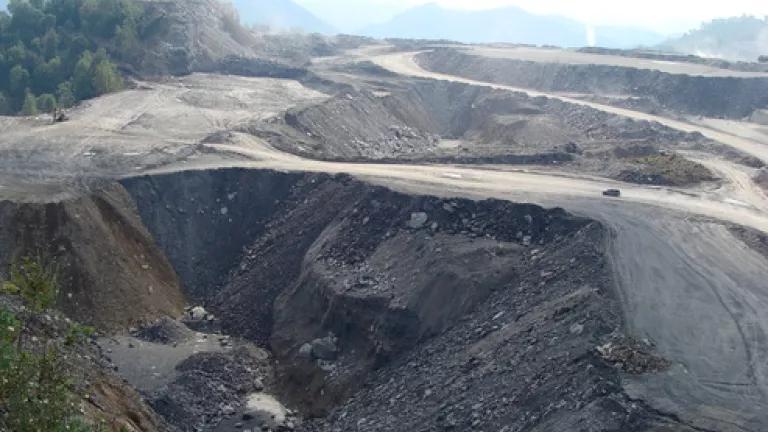
Last week, I attended the New York City premiere of “The Last Mountain,” a sobering documentary about the coal industry’s devastating mountaintop removal practices in the Appalachian Mountains. As I watched, I was struck by how little most New Yorkers know about this ongoing tragedy, although it is occurring only five hundred miles from Times Square.
The film follows environmental lawyer Bobby Kennedy, Jr. as he travels around West Virginia’s coal country, speaking with families living and working in the shadow of Coal River Mountain. This natural peak is called “The Last Mountain” because – as country star EmmyLou Harris observed – it’s just about the only mountain in the community that the coal mining industry hasn’t blown up yet.
According to the film, Massey Energy – the third largest coal company in the U.S. – has followed the same destructive pattern since arriving in the Coal River Valley in 2000. First, the company dynamites the majestic mountaintops. Then it brings in giant earth-moving equipment to tear up the trees and landscape and heave them into the low-lying hollows and streams to get at the coal.
Massey has been cited for tens of thousands of permit violations for its practices over the decade. But the relatively mild penalties that have been assessed have not succeeded in changing the company’s behavior. And loopholes in the law have allowed the Massey blasting to continue.
As a consequence, the people living in the valley – the real stars of the film – have faced public health risks like sooty air, contaminated drinking water, flooding, and falling rocks from the blasting. Residents report increased cancer rates in their community and suspect mining-related well water contamination as the cause.
Not to mention, the beautiful ridges are gone.
Those who are bravely standing up to Massey to protect their last mountain have a steep hill to climb. There’s the economic dependency that’s been created by the coal industry and the performance of local elected officials and government agencies that seem to be at the beck and call of industry. (This is despite the fact, as the film points out, that mountaintop mining practices have actually led to decreased employment for local miners, compared to traditional mining operations.)
But mountaintop removal mining isn’t just an issue for people living in valley. Maria Gunnoe – a Coal River Valley resident featured in the film and a 2009 Goldman Environmental Prize winner – put it best:
You’re connected to coal, whether you realize it or not. Everybody’s connected to this, and everybody’s causing it, and everybody’s allowing it.
She’s right. About 13 percent of New York State’s electricity comes from coal. We’re linked to this unsustainable resource every time we flip on a light switch and forget to turn it off.
Of course, there are solutions to just about every problem, as Allen Hershkowitz – NRDC’s senior scientist who is spearheading the organization’s campaign against mountaintop removal mining – points out in the film. And Coal River Mountain, as it turns out, is a darn good location for wind farms, which could bring green jobs to the community.
New Yorkers who see this film might logically leave the theater thinking about what they can do to make their homes and apartments more energy-efficient.
Another useful reaction for New York City residents is to purchase their electricity from green power – GreenPowerNYC. This option is available to both property owners and renters.
One group that should definitely see this movie is the management team at Con Edison, New York City’s energy provider. Right now, Con Ed is fighting state legislation – the Solar Jobs Bill – that would accelerate solar power projects in New York by requiring utilities to buy solar power generated by New York homes and businesses. Con Ed’s chieftains are asleep at the switch on this one.
"The Last Mountain" also has relevance to the hotly contested issue of shale gas drilling here in New York, where rushed and ill-advised proposals for widespread drilling have set off alarm bells. The film provides a reminder of what happens when industry extracts energy resources while ignoring the environmental and public health impacts of its actions.
After the film concluded, our colleague Bobby Kennedy spoke with the audience. He observed that these days, when so much of the “news” presented to the American people is trivial or irrelevant, well-produced documentaries have become important vehicles for telling powerful environmental stories. We know more about climate change thanks to Al Gore’s “An Inconvenient Truth.” We have learned about the dangers of shale gas fracking from Josh Fox’s “Gasland.” And, said Bobby in congratulating director Bill Haney, we hope that “The Last Mountain” will play a similar role in waking up the nation to the indescribable harm being done to the Appalachian countryside by mountaintop removal mining.
Take a look at the trailer for "The Last Mountain." It opens at the Landmark Sunshine Cinema in New York and at theaters nationwide on June 3. See for yourself what short-sighted policies are doing to our planet and how inspiring citizens are taking action in a valiant effort to turn things around.
We have a few ways you can keep up with our work online: Please visit our website at www.nrdc.org/newyork or follow us on Facebook and Twitter.
